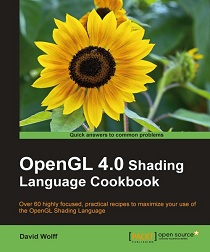OpenGL 4.0 Shading Language Cookbook
eBook Details:
- Paperback: 340 pages
- Publisher: WOW! eBook (July 26, 2011)
- Language: English
- ISBN-10: 1849514763
- ISBN-13: 978-1849514767
eBook Description:
Over 60 highly focused, practical recipes to maximize your OpenGL Shading 4.0 language use
- A full set of recipes demonstrating simple and advanced techniques for producing high-quality, real-time 3D graphics using GLSL 4.0
- How to use the OpenGL Shading Language to implement lighting and shading techniques
- Use the new features of GLSL 4.0 including tessellation and geometry shaders
- How to use textures in GLSL as part of a wide variety of techniques from basic texture mapping to deferred shading
- Simple, easy-to-follow examples with GLSL source code, as well as a basic description of the theory behind each technique
In Detail
The OpenGL Shading Language (GLSL) is a programming language used for customizing parts of the OpenGL graphics pipeline that were formerly fixed-function, and are executed directly on the GPU. It provides programmers with unprecedented flexibility for implementing effects and optimizations utilizing the power of modern GPUs. With version 4.0, the language has been further refined to provide programmers with greater flexibility, and additional features have been added such as an entirely new stage called the tessellation shader.
The OpenGL 4.0 Shading Language Cookbook provides easy-to-follow examples that first walk you through the theory and background behind each technique then go on to provide and explain the GLSL and OpenGL code needed to implement it. Beginning level through to advanced techniques are presented including topics such as texturing, screen-space techniques, lighting, shading, tessellation shaders, geometry shaders, and shadows.
The OpenGL 4.0 Shading Language Cookbook is a practical guide that takes you from the basics of programming with GLSL 4.0 and OpenGL 4.0, through basic lighting and shading techniques, to more advanced techniques and effects. It presents techniques for producing basic lighting and shading effects; examples that demonstrate how to make use of textures for a wide variety of effects and as part of other techniques; examples of screen-space techniques, shadowing, tessellation and geometry shaders, noise, and animation.
The OpenGL 4.0 Shading Language Cookbook provides examples of modern shading techniques that can be used as a starting point for programmers to expand upon to produce modern, interactive, 3D computer graphics applications.
What you will learn from this book :
- Compile, install, and communicate with shader programs
- Use new features of GLSL 4.0 such as subroutines and uniform blocks
- Implement basic lighting and shading techniques such as diffuse and specular shading, per-fragment shading, and spotlights
- Apply single or multiple textures
- Use textures as environment maps for simulating reflection or refraction
- Implement screen-space techniques such as gamma correction, blur filters, and deferred shading
- Implement geometry and tessellation shaders
- Learn shadowing techniques including shadow mapping and screen space ambient occlusion
- Use noise in shaders
- Use shaders for animation
Approach
This hands-on guide cuts short the preamble and gets straight to the point – actually creating graphics, instead of just theoretical learning. Each recipe is specifically tailored to satisfy your appetite for producing real-time 3-D graphics using GLSL 4.0.
Who this book is written for
If you are an OpenGL programmer looking to use the modern features of GLSL 4.0 to create real-time, three-dimensional graphics, then this book is for you. Familiarity with OpenGL programming, along with the typical 3D coordinate systems, projections, and transformations is assumed. It can also be useful for experienced GLSL programmers who are looking to implement the techniques that are presented here.
[download id=”266″ format=”1″]
